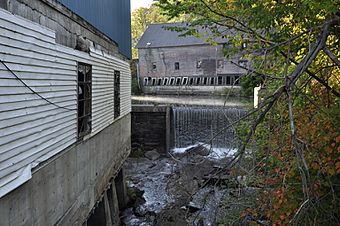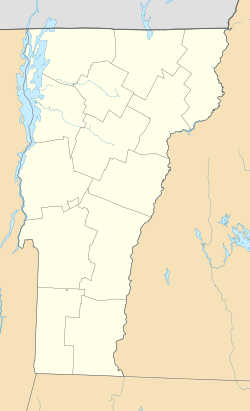Crystal Lake Falls Historic District facts for kids
Quick facts for kids |
|
|
Crystal Lake Falls Historic District
|
|

Part of Barton's industrial heritage
|
|
| Location | Roughly, Water St. from Church St. to Main St., Main from Water to Duck Pond Rd. and West St. from Cemetery Rd. to Main Barton, Vermont |
|---|---|
| Area | 12 acres (4.9 ha) |
| NRHP reference No. | 94000699 |
| Added to NRHP | August 7, 1994 |
The Crystal Lake Falls Historic District, also known as the Brick Kingdom, is a special area in Barton, Vermont, United States. It's a place where old factories and homes tell the story of how people used to work and live there. This district is located near Water Street and Main Street, right beside Willoughby Brook. The brook's flowing water was super important because it powered all the industries in the area. This historic district was added to the National Register of Historic Places on August 7, 1994. This means it's officially recognized as an important historical site in the U.S.
Contents
A Look at the Crystal Lake Falls Historic District
The Crystal Lake Falls Historic District covers several blocks in Barton village. It's found at the northwest corner of Crystal Lake. The district stretches along Water Street, Main Street, and West Street. This area is often called the "Brick Kingdom."
What is the Brick Kingdom?
The "Brick Kingdom" runs alongside Willoughby Brook. This brook flows out of Crystal Lake. It drops about 90 feet (27 meters) in a series of waterfalls. This drop created a lot of power. Early industries used this power to run their machines.
The first factories here started in the late 1700s. In 1798, Asa Kimball opened a sawmill. A few years later, in 1807, he started a gristmill. A gristmill grinds grain into flour.
How Water Power Helped Barton Grow
During the 1800s, many factories opened along Water Street. They made all sorts of things. Some factories produced parts for pianos. Others made furniture or ladies' cotton underwear. Even baseball bats were made here!
These factories were very important to Barton. They employed about 300 workers. Most of these businesses closed by the 1940s. The last one left in 1952.
Factories and Businesses of the Past
Many different types of businesses operated in the Crystal Lake Falls Historic District. Here are some examples:
- Heyward Chair Company (1860–1890): This company made chairs for many years.
- Charles Ufford Carriage Maker (1868 – around 1892): This business built carriages. Carriages were like cars before automobiles existed.
- Barton Woolen Mill (1875–1926): This mill processed wool. It was one of the last wool carding mills in the country. Carding is a step in preparing wool for spinning into yarn.
- J.W. Murkland (1876–1941): This company was a big machinery maker. They had a foundry and produced things like plows and parts for textile machines.
- Peerless Manufacturing Company (1892–1924): This factory employed about 100 women. They made ladies' and children's underwear.
- Butter Tub Factory (1893–1916): This factory made wooden tubs for butter. It employed up to 60 men. When a fire destroyed the factory in 1916, many people lost their jobs. This caused many families to move away from Barton to find work.
- Wessell, Nickel and Gross (1919–1941): This company made "piano actions." A piano action is the complex part inside a piano that makes the hammers hit the strings when you press a key. They employed up to 42 men.
- Progressive Furniture Company (1944–1952): This company made wooden chairs. It employed about 30 people.
- Barron Wedgewood Horseshoe (1908–1920): This company made a special type of horseshoe. These horseshoes were designed to prevent snow from building up on a horse's hooves.
- Commercial Ice Harvesting (1870–1947+): Before refrigerators were common, ice was harvested from Crystal Lake. This ice was then stored and sold.
- Granite Quarries (1888 – around 1935): Local quarries mined granite, a strong stone used in building.
This historic district shows how important water power was to the growth of towns like Barton. It reminds us of the many different jobs people had in the past.



